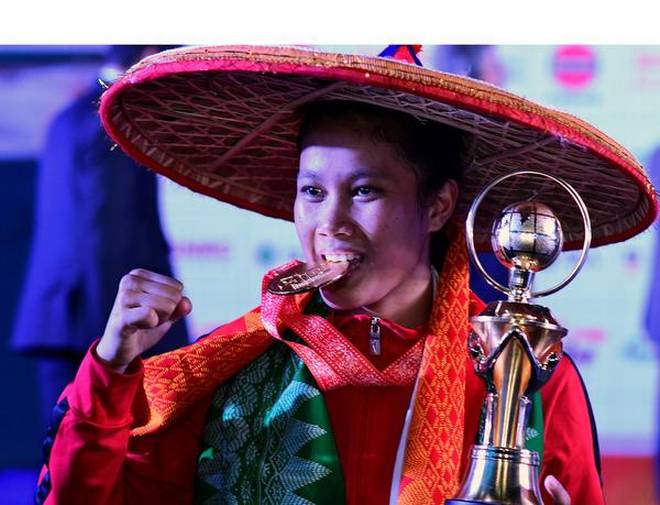Ankushita Boro
This is a collection of articles archived for the excellence of their content. |

From: Y.B. Sarangi, December 2, 2017: The Hindu
2017
Achievements, in brief
Y.B. Sarangi, December 2, 2017: The Hindu
If any boxer from Assam has gathered the maximum attention after world championship medallist Shiva Thapa, it has to be 17-year-old Ankushita Boro. A tribal girl hailing from the nondescript Meghai Jarani village in Sonitpur district of upper Assam captured the imagination of thousands of sportslovers in Guwahati, where she became one of the five Indians to earn a gold medal in the world youth women boxing championship.
Another Assamese girl, Minu Basumatary, had secured the same title in the same 64-kg weight class in the inaugural edition of the event in Turkey in 2011. Ankushita left her Statemate behind by miles in terms of the impact she created in front of her own people.
How did she get into boxing?
Ankushita’s love for boxing was a thing of surprise for many in her native place. Forget women’s boxing; Meghai Jarani, situated 200 km away from Guwahati, did not have any boxing culture whatsoever. However, when the 12-year-old found the gloves and the headgear attractive, her family with a humble background never resisted despite belonging to a conservative village.
It was a big decision for her father Rakesh Kumar, a primary school teacher on probation, who does not get his salary regularly, and mother Ranjita, who works for an NGO.
They showed courage and helped Ankushita travel 165 km for the trials at the Sports Authority of India (SAI) centre in Golaghat. After securing admission in the SAI centre, Ankushita made rapid strides. She was lucky to get proper guidance from her coaches — Pranamika Bora at Golaghat and Tridib Bora — at the State academy in Guwahati.
How did she fare?
A good show resulting in a bronze medal in the national youth championship in 2017 gave Ankushita the key to unlock her future. She collected silver medals in exposure trips such as the Ahmet Comert international tournament in Turkey and the Balkan youth international tournament in Bulgaria to stake her claim for a spot in the national squad.
The skills of Ankushita, a naturally gifted boxer with nimble footwork, swift hands and rock-solid determination, got polished under the watchful eyes of the expert from Italy, Raffael Bergamasco, who taught her how to make subtle movements and gain maximum advantage in the ring. Five months of training under Bergamasco made Ankushita a better boxer and readied her for the bigger test ahead.
What happened at world event?
The competitive Ankushita had revenge on her mind even before she got into the ring at the world youth championship. She beat Cagla Aluc of Turkey to avenge her defeat at the Ahmet Comret tournament and then overcame a strong Rebecca Nicoli of Italy in another grudge match despite being hit on her right eye.
In the final, the local favourite gave her best against Ekaterina Dynnik, though the Russian was the toughest of all her rivals.
What does it mean for women?
Ankushita’s next targets should be the world elite women’s championship in India next year and the 2020 Olympics. Since her weight class does not feature in the Olympics, Ankushita may go up a notch to 69 kg to seek qualification for the Tokyo Games.
Nevertheless, Assam’s newest boxing sensation will surely spur younger girls, including those from her own district, to take up the gorgeous sport.
With the increase in medals share for women’s boxing in the Olympics owing to the International Olympic Committee’s stress on gender equality, Ankushita’s feat may act as the trigger point for India at a time when the legendary M.C. Mary Kom era is entering its last phase.